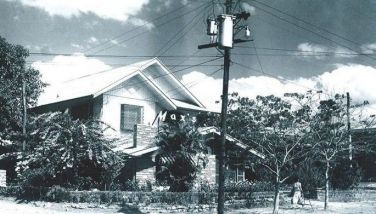Distant

Donald Trump just added another condition for the resumption of talks to end the trade war between the two largest economies: a peaceful resolution to the political crisis now plaguing Hong Kong.
That effectively meant that the end to the trade war has just become more distant and less imminent. The trade war, sparked by the Trump administration’s imposition of tariffs on Chinese exports to the US, has become a major factor influencing the deepening global downturn.
The twists and turns of this unpredictable trade war has influenced the performance of the world’s stock markets and the movement in the price of oil more than any other factor – more than the flashpoints in the Middle East or Brexit or the financial distress of some of South America’s largest economies.
Last Tuesday, convinced by his advisers that the additional 10 percent tariffs on the rest of China’s exports would ruin the Christmas mood, Trump postponed its implementation to Dec. 15. But on the very next day, as signals of the global economy’s distress grew, the US stock exchange took one of its biggest falls to date.
The longer the trade war rages, the worse off global economic prospects will be. The adverse outcomes, unfortunately, are not limited to the two warring economies. The growth performance of all economies will weaken as the trade war carries on.
At the moment, the Hong Kong protests that have been going on for 11 weeks are not likely to subside. Each day that passes makes the possibility of armed intervention greater. China has assembled a large militia force in nearby Shenzhen with what appears to be thousands of men and hundreds of armed vehicles.
More that everybody else, Beijing realizes that intervening militarily in Hong Kong will have disastrous consequences. Hong Kong’s economy could go into a tailspin, dragging down even China’s own economy. The damage to China’s reputation could be irreversible for years.
Instead of armed intervention, China appears to be contemplating a closer integration of the economies of Hong Kong, Macau and Shenzhen into a “Greater Bay Area.” China’s State Council recently issued a 19-point directive to this end. This integration, seen to be completed by 2025, should “enrich the practice of the ‘one country, two systems’ policy.”
Quite ominously, the directive calls for the “modernization of social governance” in Shenzhen by way of the “comprehensive application of bid data, cloud computing, artificial intelligence and other technologies.” Shenzhen is headquarters for some of China’s most overachieving tech companies such as Huawei and Tencent.
By weaving Hong Kong, Macau and Shenzhen closer together, Beijing clearly hopes to quash the dissent we saw that past few weeks in the streets of Hong Kong.
Inadequate
The move was expected.
Last week, the Tariff Commission approved the replacement of the provisional safeguard tariffs of P8.40 per 40-kilo bag of cement with a permanent tariff of 12 percent on the commodity. The measure is intended to safeguard Filipino cement manufacturers from the onslaught of cheaper imported cement mainly from Vietnam.
Over the last few years, cement imports have been surging, taking advantage of a tariff-free trading environment. The surge in cement imports threatened the viability of the domestic cement industry that contributes to the nation’s GDP, pays P24 billion in taxes and provides jobs for hundreds of thousands of Filipino workers.
In the first half of 2019, cement imports soared to 3.4 million tons, a 48.2 percent increase over the 2.29 million tons imported in the same period last year. Back in 2013, cement imports were virtually non-existent. Since then, a group of traders, taking advantage of a glut in the regional market and a free-trade arrangement with all the ASEAN countries, began importing feverishly.
Demand for cement was boosted by government’s ambitious infrastructure program. Domestic cement manufacturing capacity stands at 28 million metric tons, just shy of demand. More domestic capacity, however, will soon increase as investments have been made in new plants.
Government’s ability to monitor the quality of cement imports is limited, given rising import volumes. Should inferior quality cement fill the market, we will have little recourse to run after suppliers of inferior products. The importers employ very few workers, being traders instead of manufacturers.
The massive surge in imports in the first half of the year defies the earlier safeguard duties imposed on the commodities. That underscores the inadequacy of the safeguard measures to prevent dumping of inferior products.
Our cement manufacturers are happy the Tariff Commission made the duties permanent and raised these to P12 per bag of the product. They are, however, asking both the Tariff Commission and the Department of Trade and Industry to review the level of duties imposed. In order to prevent destructive price undercutting, the manufacturers think the tariff level should be raised to between P18 to P22 per bag.
The domestic cement industry accounts for a full 1 percent of GDP. It contributes more through taxes as a percentage of the value of its produce. It employs a large number of workers. It has attracted new investment to further grow our manufacturing base. It, therefore, deserves to be protected in the face of a regional glut in cement production.
Cement and steel are indispensable products we need to produce to help modernize our economy. After decades of underinvesting in our nation’s infrastructure, we have a lot of catching up to do to match the rest of region in competitiveness.
Our manufacturers, anticipating the construction boom, dared to invest heavily in new production capacity. That deserves protection.
- Latest
- Trending



























